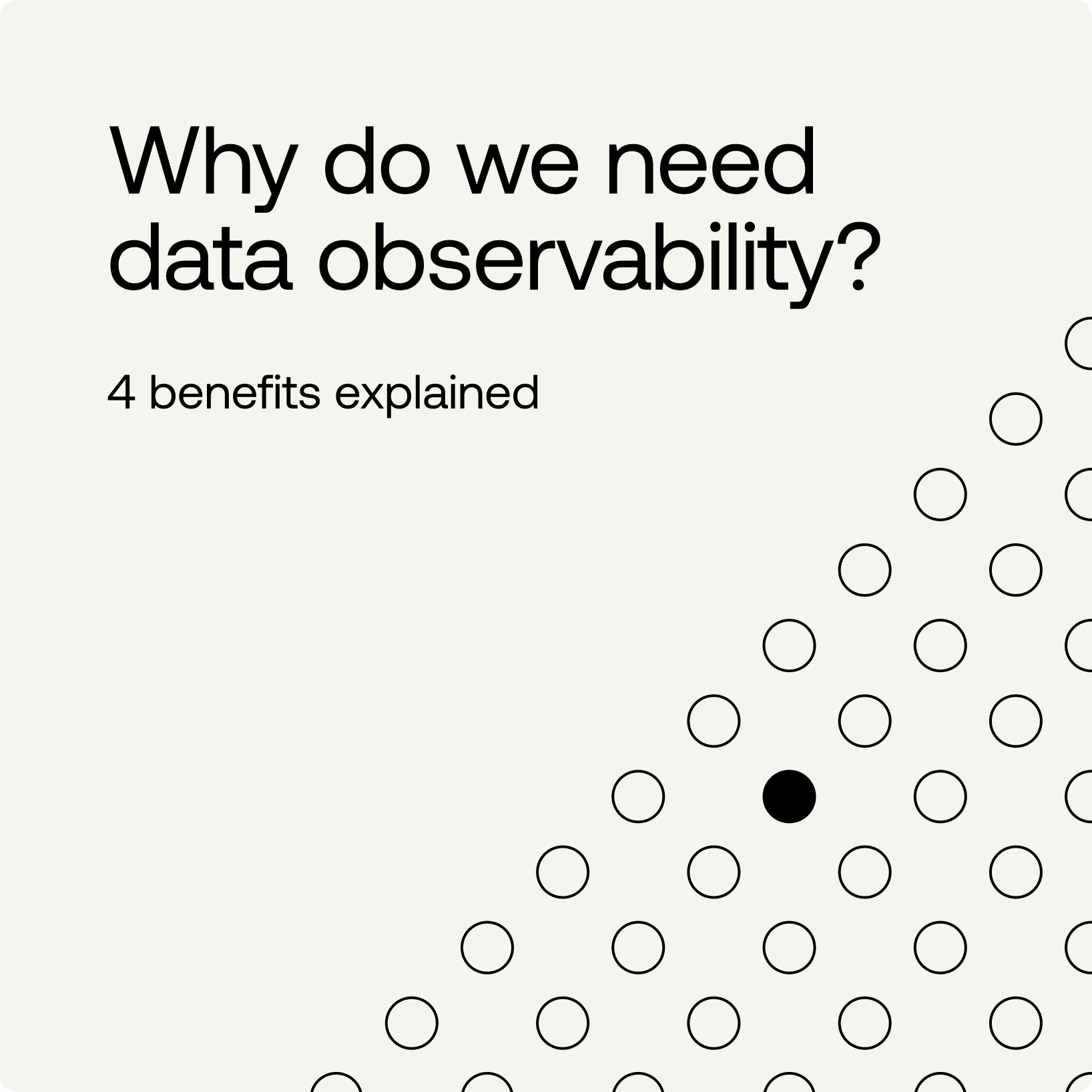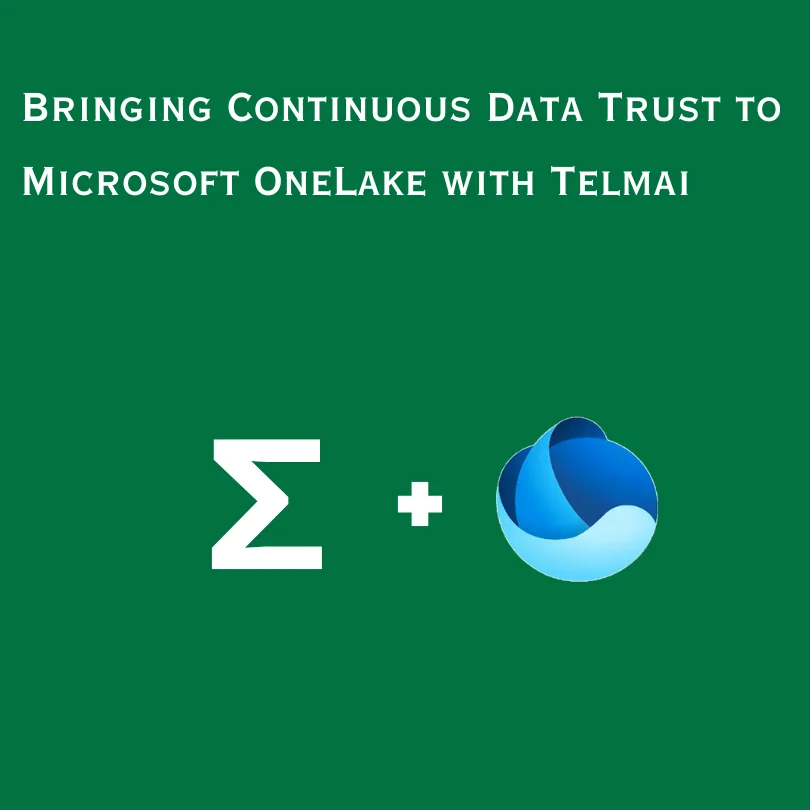Why do we need data observability? 4 Benefits explained
Data teams are discovering the importance of Data Observability and its distinction from traditional data quality checks. This article explores four reasons why data observability is crucial for modern data stacks, the unique benefits of Telmai, and how it addresses the complexities of today’s data ecosystems.

This question comes up as data teams start to learn more about Data Observability and how it is different from traditional data quality checks that they have implemented over the years.
Here are 4 reasons why data observability is a critical component of any modern data stack, followed by why Telmai and what makes it unique.
Today, companies are dealing with a much more complex data ecosystem. With investments in data and analytics and the burst of new data products, a tangle of data pipelines has grown over time. Each company hires data engineers to operate these data pipelines, debug changes, and mitigate issues before they cause downstream effects. What used to be managed with data quality checks based on pre-defined business rules has become too unpredictable and therefore requires a new approach.
Here are 4 reasons why:
1. Proactive detection of unknown issues using ML
In the past, data quality engines were set up through rules. However, rules-based systems don’t cut it anymore. Rules break as data changes over time.
Instead of configuring and re-configuring what to check for, data observability relies on unsupervised learning and detects anomalies and outliers even if it was not programmed to do so. By using time series and historical analysis of data, Data Observability tools create a baseline for normal behavior in data and automate anomaly detection when data falls outside historical patterns or crosses certain thresholds.
2. Real-time monitoring and alerting
Data observability tools continuously monitor data flows and alert teams to anomalies or drifts. With this approach, you can automate quality checks and flag faulty data values as often as they happen and before any downstream impact.
You can set up monitors to run on an hourly, daily, or weekly basis and automatically see alerts and notifications via slack or email when your data falls outside expected norms. Once an issue has been identified, these tools can also provide recommendations for remediation, enabling swift corrective action before the problem escalates.
3. Root cause investigation
When data quality issues are exposed, data observability tools have the means to show the root cause of these issues.
The root cause analysis exposes the underlying data values and patterns contributing to faulty data. Data lineage further expands these discoveries to expose associated tables, columns, and timestamps of outliers, pattern changes, or drift in the data as soon as the change occurs. This helps data teams remediate these issues faster.
4. Shared data quality ownership
While traditionally, data quality management was done by IT because of the technical nature of tools, it was never clear who is the data quality owner. This led to much firefighting and dealing with data issues between teams.
With data observability, a visual, no-code interface facilitates collaboration between business and technical teams. This intuitive interface helps them directly see data quality issues in motion, learn from historical trends, and establish validation rules to monitor data quality without having to code or go back and forth on business policies.
Why Telmai
While most data observability tools have some things in common, including the 4 we outlined above, they have been built with different architectures and for different use cases.
Here are 5 areas that make Telmai unique. Here are 5 areas that make Telmai unique.
The right combo of ML and data validation rules
Telmai learns from your data, identifies issues and anomalies as they occur, and predicts expected thresholds out of the box. You can extend this unsupervised learning with your own rules and expectations to customize the system to your needs. This combination of unsupervised and supervised learning provides tremendous power while giving you the flexibility and customization to tailor your data quality monitoring to your requirements.
Data quality regardless of the data type
Traditionally, data quality was part of an ETL flow. As the data was transformed to fit into a reporting layer, it went through a cleaning process. Today data is sourced from various places, and data transformations happen in databases, in source or target systems, or somewhere in between.
With Telmai, you can plug data quality checks anywhere in your pipeline, regardless of the data type (e.g. structured, semi-structured data, streaming) or data storage (e.g. cloud warehouse, data lake, blob storage) you have in place. You are not limited to data sources that have a SQL interface or carry strong metadata to help you infer data quality at an aggregated level.
Data quality at scale and volume
Using Telmai, you can analyze the quality of your data at the attribute level in its full fidelity. This is even more powerful when Telmai allows you to see data quality issues for any given point in time, as well as historically and continuously, for always-on monitoring.
With Telmai, You are not limited to samples that will hide data quality issues. You are also not limited to the amount of data validation queries you run against your database. Telmai analyzes data quality in its own scalable, Spark architecture so that you won’t clog up the performance of your underlying data warehouses.
Low TCO
Built-in automation, ML-based anomaly detection, and out-of-the-box data quality metrics will not only save you time and resources in setting up your data validation processes but also in maintaining them over time. Additionally, Telmai’s Spark-based data quality analysis layer eliminates the need to push validation rules and SQL queries into your analytic databases, which will, in turn, increase their licensing costs. With Telmai, you get powerful data quality monitoring without the high cost.
A future-proof architecture
As your data stack changes, you don’t have to change your data quality logic, SQL code, or native scripts that were previously investigating your data. With Telmai, you have an open architecture that can validate a field in Snowflake precisely the same as in Databricks or even a system with no SQL interface or a strong metadata layer – all within a no-code user-friendly interface.
Passionate about data quality? Get expert insights and guides delivered straight to your inbox – click here to subscribe to our newsletter now.
- On this page
See what’s possible with Telmai
Request a demo to see the full power of Telmai’s data observability tool for yourself.
